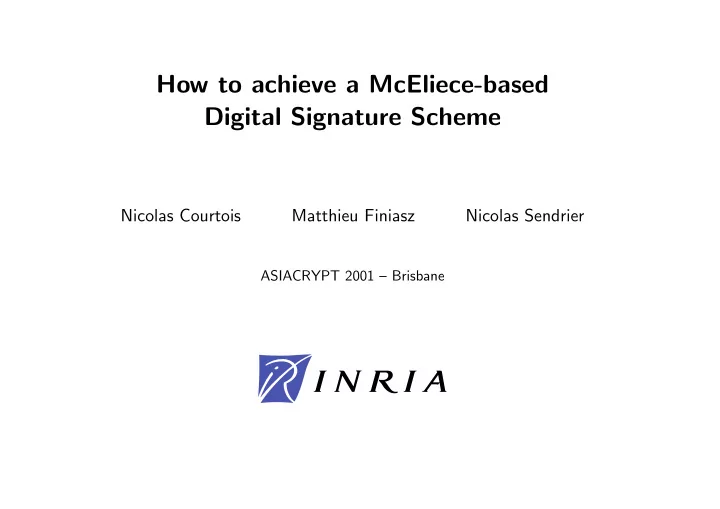

How to achieve a McEliece-based Digital Signature Scheme Nicolas Courtois Matthieu Finiasz Nicolas Sendrier ASIACRYPT 2001 – Brisbane
McEliece in a nutshell (Niederreiter version) ⇒ This scheme is equivalent to the original McEliece scheme, but is more practical. 1
From Public-key Cryptography to Digital Signature ⇒ A digital signature consists in adding a few bits to a file in order to prove both its origin and its content. ⇒ Any public key cryptosystem can be transformed in a signature scheme like this: 2
Using error-correcting codes. . . To perform this with McEliece, one has to be able to decode any syndrome returned by the hash function. ! Niederreiter coding is not a one to one mapping. ⇒ some syndromes are not the image of a message With the original parameters: t = 50 , m = 10 , n = 1024 . � there are 2 500 different syndromes (of length 500 ) ≃ 2 284 sums of 50 columns of H � 1024 � � there are 50 ⇒ This makes a ratio of 1 decodable syndrome out of 2 216 . We need to: � find a way to decode any syndrome � or find a decodable syndrome related to the document 3
Solving this problem ⇒ we need to take advantage of the t -error decoding method Find a way to decode more syndromes: decode syndromes corresponding to error patterns of greater weight ⇒ possible using exhaustive search Find a decodable syndrome ⇒ Add a counter i to the document: � Hash the document and the counter at the same time: [ · · · D · · · ][ · i · ] − → h i � Try to decode each h i until one is decodable � We denote i 0 the smallest index such that h i 0 is decodable ⇒ In both cases we need to change the parameters to obtain a better ratio. 4
Better parameters The ratio of decodable syndromes is easy to calculate: � n � R = N dec 1 t = ≃ 2 n N tot t ! n large ⇒ Hash document + counter t ! times in average to obtain a decodable syndrome ! Telling if a syndrome is decodable is as hard as decoding it ⇒ We need to perform t ! decodings, each one having a complexity of t 2 (log 2 n ) 3 n only has a small influence: we will choose t to have a reasonnable signature time. t shouldn’t be greater than 10 , preferably 9 . 5
Secure parameters We have a small t but still want a good security (about 2 80 CPU operations) ⇒ n will be large t = 9 t = 10 n 2 13 2 69 . 3 2 72 . 3 2 14 2 74 . 0 2 77 . 4 Number of binary 2 15 2 78 . 8 2 87 . 4 operations for an attack 2 16 2 83 . 7 2 90 . 9 2 17 2 88 . 2 2 94 . 6 � t = 10 and n = 15 t = 9 and n = 16 ← − 10 times faster 6
Signature size ⇒ we index all the words of weight 9 and length 2 16 . � 2 16 � one index between 0 and 9 the counter i 0 with an average value of 9! ⇒ The counter must be present for verification. It can be made of fixed length. ⇒ Signature is in average 144 bits long. 7
Reducing the signature size. . . Verification is very fast (summing 9 columns of H and hashing one file) ⇒ The signature can be shortened by omitting some information: verificator will then try all possible values ⇒ Signature will contain less than t positions omitted signature length verification positions partial total WF time 0 125 . 5 144 9 ∼ µ s 1 112 . 7 131 9 ∼ µ s 2 14 ∼ ms 2 99 . 7 118 2 27 ∼ 30 s 3 86 . 5 105 2 40 4 73 . 1 92 — 2 54 5 59 . 4 77 — We can verify a signature of 105 bits in about 30 seconds. 8
Reducing more We can reduce the signature size even more by giving only approximate positions ⇒ group the columns in small clusters of 16 columns ⇒ The matrix can easily be transformed with a Gaussian elimination (about 2 24 column operations). We then have the same problem to solve. ⇒ We can get signatures of 81 bits. 9
Scalability ⇒ The signature algorithm is easily scalable. For one omitted position we have the following asymptotic values: t ! t 2 m 3 signature cost signature length ( t − 1) m + log 2 t t 2 m verification cost tm 2 m public key size 2 tm (1 / 2+ o (1)) cost of best decoding attack ⇒ Security increases much faster than any other parameter 10
Conclusion ⋆ Signature using McEliece is possible! ⋆ The algorithm obtained is polymorphic. It gives: � either very short signatures of 81 bits � or short signatures ( 131 or 118 bits) with a faster verification ⋆ the signature time is long (about 1 minute) ⋆ the public key is large ( 1 MB) ⋆ its security relies on well known hard problems ⋆ it is easily scalable 11
Recommend
More recommend